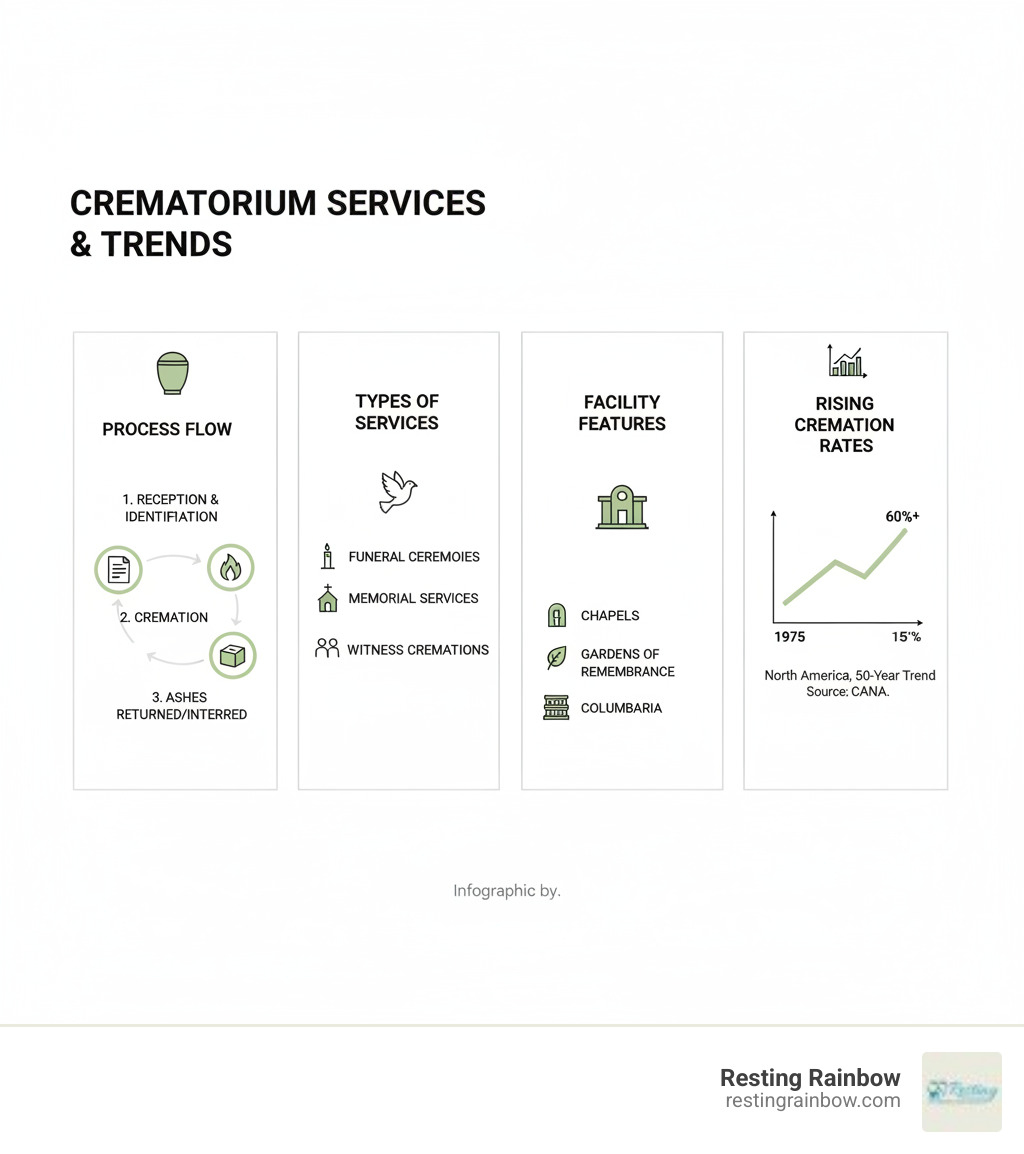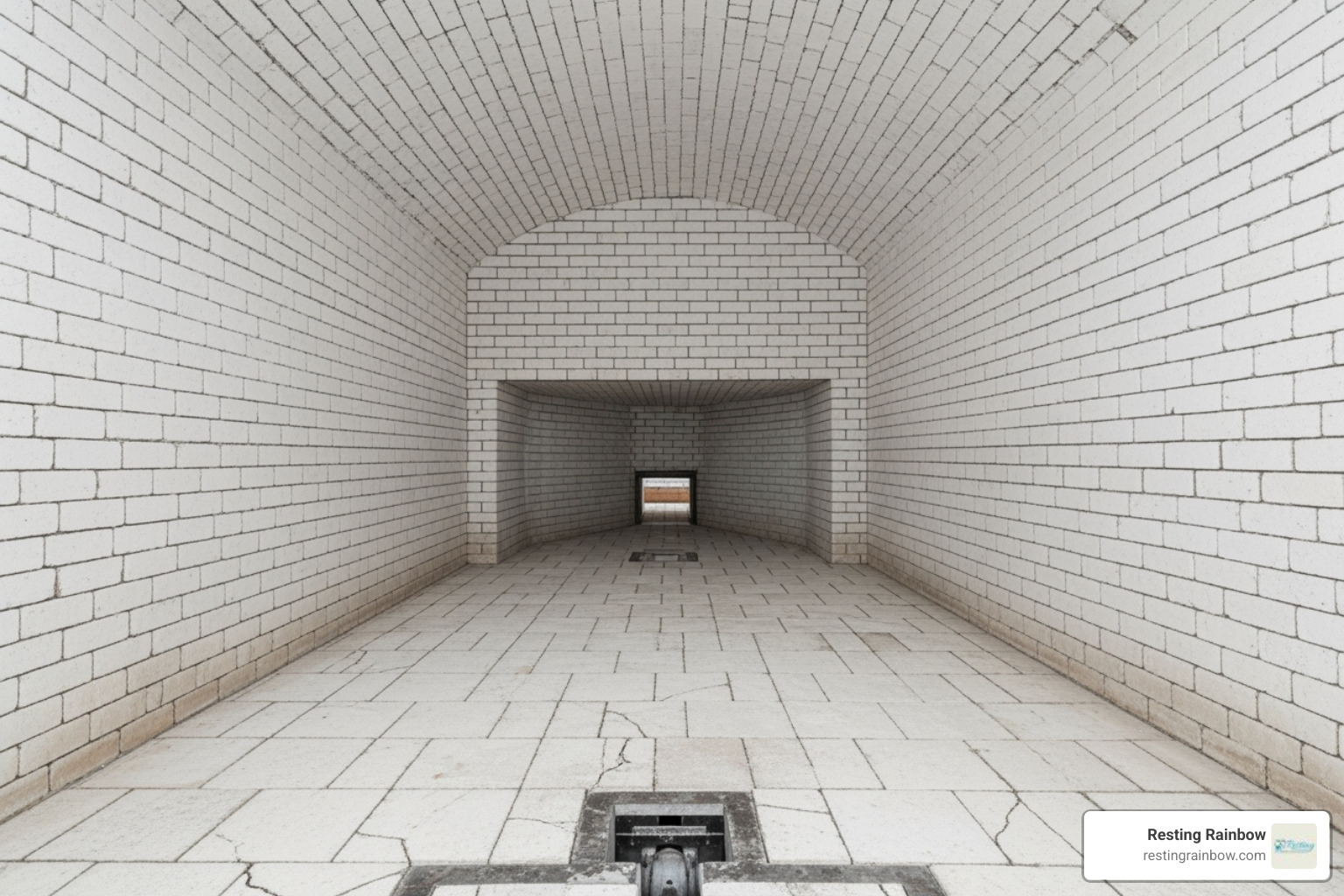October 7, 2025

A crematorium is a specialized facility for the dignified cremation of human or pet remains, offering a meaningful alternative to traditional burial. These venues blend advanced technology with compassionate care, providing services that range from memorial ceremonies to witness cremations and ash scattering. Modern facilities often feature chapels, gardens of remembrance, and advanced tracking systems to ensure peace of mind.
The popularity of cremation has increased dramatically over the past several decades, reshaping how families approach end-of-life planning. According to industry research from the Cremation Association of North America (CANA), cremation rates in the United States have risen steadily for more than 50 years as families seek flexibility, simplicity, and personalized memorial options. Today’s crematoriums are designed not only to meet technical and regulatory standards but also to provide a serene, inclusive setting for reflection and remembrance.
Far from their industrial origins, modern crematoriums are sacred spaces for grieving and celebration. With carefully planned architecture and state-of-the-art equipment operating at 1,400–1,800°F, the process is performed with dignity and precision in about 1–3 hours. Equally important are the safeguards behind the scenes: chain-of-custody protocols, unique ID tags, and meticulous records ensure accuracy and trust at every step.
Crematoriums serve multiple roles in a community. They support traditional funerals and celebrations of life, provide private rooms for families who wish to witness the committal, and maintain gardens where ashes can be returned to the earth. Increasingly, they also care for beloved animal companions—recognizing pets as family and offering specialized, compassionate pet aftercare.
I'm Joseph Castranova, co-founder and CEO of Resting Rainbow. We built our pet crematorium operations on transparency and compassion after losing our own beloved pets. My experience has shown me how these facilities can provide profound closure for grieving families, a principle that guides our services across every community we serve. Our team focuses on respectful care, efficient turnaround, and clear communication, ensuring families feel supported and informed throughout.
As cremation becomes more common, families benefit from more choices: private witness cremations, eco-conscious alternatives under evaluation, and memorials that reflect personality and values. The heart of it all is dignity—for every life and every goodbye.

The practice of cremation is not a modern invention; it's a tradition that stretches back thousands of years. Ancient civilizations, from the Greeks and Romans to the Vikings, used fire in sacred rituals to honor the departed, believing it purified the soul for its journey to the afterlife. Archaeological findings across Europe and Asia reveal urnfields and cremation burials dating to the Bronze Age, underscoring cremation's deep cultural roots.
After centuries of burial being the dominant practice in the West, cremation saw a revival in the 1800s. As cities grew, public health concerns over crowded cemeteries led doctors and reformers to advocate for cremation as a safer, cleaner alternative. Industrialization and urbanization made public sanitation a pressing issue, and cremation offered a practical solution that gradually helped overcome cultural and religious objections.
The Industrial Revolution provided the technology to make modern cremation a reality. The invention of the regenerative furnace by Sir Charles William Siemens in the 1850s was a key breakthrough, enabling more efficient and controlled combustion. Building on this, Professor Paolo Gorini developed a modern cremation apparatus, leading to the world's first modern crematorium in Milan in 1876. That same year, Dr. Francis Julius LeMoyne opened the first crematorium in the United States in Washington, Pennsylvania, marking a turning point in American funerary practices.
Early crematoriums were functional, industrial buildings. Over time, their design evolved to incorporate chapels, viewing rooms, and peaceful gardens of remembrance, changing them into sanctuaries for grieving families. This shift was mirrored by a change in public opinion. Once considered taboo, cremation gained widespread acceptance as religious views softened and families came to appreciate the flexibility it offered for memorialization. For a concise overview of the global and U.S. history of cremation, see CANA’s History of Cremation and a general reference from Encyclopaedia Britannica.
Today, many crematoriums offer both human and pet services. Pet aftercare reflects the same values of dignity, accuracy, and family-centered support, recognizing that the bonds we share with animals are profound and deserving of thoughtful remembrance. In this way, modern cremation carries a long tradition forward—using change by fire to honor a life and create space for healing.
Modern crematoriums blend cutting-edge technology with respectful tradition, all designed to provide families with dignity and peace of mind.

At the heart of the facility is the cremator, or retort—a highly sophisticated furnace lined with refractory brick to withstand extreme heat. Most modern cremators use a dual-chamber system. The primary chamber holds the deceased, while a secondary chamber operating at even higher temperatures ensures complete combustion and minimizes emissions. Sensors, programmable logic controllers, and airflow management systems allow trained operators to carefully control time, temperature, and turbulence for efficient, respectful operation.
The process is a carefully managed sequence designed for accuracy and respect:
Behind every cremation is a certified operator trained in both the technical process and compassionate family care. Their role is to ensure every step is handled with dignity and accuracy, supported by meticulous record-keeping systems that provide families with absolute confidence. Many professionals complete formal training and continuing education through recognized programs such as CANA’s education and certification courses.
Today's crematorium facilities are committed to environmental responsibility. Advanced combustion controls, secondary burners, and after-chambers are used to control air pollution, meeting stringent federal and state expectations. The U.S. Environmental Protection Agency provides guidance and standards related to crematories; for an overview of applicable federal requirements, see the EPA’s page on Crematories and Pathological Incinerators—New Source Performance Standards.
Many facilities are improving energy efficiency by capturing waste heat for building heating or preheating intake air, and they may implement best practices to mitigate mercury emissions from dental amalgam in human cases. The industry also continues to explore eco-friendly alternatives like aquamation (water-based cremation), which can offer significant energy savings. At Resting Rainbow, we continuously evaluate new technologies to minimize environmental impact while upholding the highest standards of care, providing families with options that balance sustainability and dignity.
A modern crematorium is more than a processing facility; it's a sacred space designed for comfort and remembrance. The architecture and services offered are thoughtfully planned to help families honor, grieve, and celebrate a life.
Modern crematoriums feature several key architectural elements:
Every farewell is unique, and crematoriums today offer flexible options. Families can choose traditional funeral services, joyful celebrations of life, or quiet, non-religious gatherings. Ceremonies might include music, readings, photo slideshows, or cultural rites. Many facilities also offer witness cremations, allowing family members to be present for the start of the process, which can be a deeply meaningful experience.
This personalization extends to pet cremations. Pet crematoriums provide intimate spaces and services that acknowledge the profound bond we share with our animal companions. At Resting Rainbow, we understand that pets are family, and our facilities are designed to provide a dignified and loving farewell with options for private goodbyes, memorial keepsakes, and gentle guidance through the process.
After cremation, there are many beautiful ways to create a lasting tribute. These options allow families to find a memorial that feels authentic and healing.

Thoughtful design, flexible ceremony options, and creative memorialization empower families to craft goodbyes that are intimate, authentic, and deeply healing.
Operating a crematorium involves a careful balance of legal requirements, ethical responsibilities, and financial realities. These standards ensure that every family is served with respect and professionalism during a vulnerable time.
Crematoriums are governed by a web of local, state, and federal regulations designed to protect public health, the environment, and the dignity of the deceased. Key requirements include:
Beyond the law, the industry is guided by a profound ethical commitment to the families it serves.
Cremation costs can vary significantly, so transparent pricing is essential. A basic direct cremation (without a service) is typically the most affordable option, while full-service packages may include viewings, memorial ceremonies, personalized keepsakes, witness options, and upgraded urns.
Factors that influence the final cost include:
Many providers, including Resting Rainbow, offer pre-planning and clear, itemized estimates. Planning ahead helps families lock in choices, budget thoughtfully, and remove the burden of decision-making during acute grief. For pet parents, knowing options in advance—private, partitioned, or communal cremation, and memorial selections—brings peace of mind.
For many of us, pets are family. The grief we feel when they pass is profound, and it deserves to be honored with dignity and respect. This understanding has led to the rise of specialized pet cremation services, offering a compassionate way to say goodbye to our cherished companions.
Pet cremation operates on the same principles of dignity as human cremation but is custom to the unique needs of pet parents. The equipment is sized for animals, staff are trained in gentle handling, and there is often a greater emphasis on personalized keepsakes like paw prints and fur clippings. Families may also choose to be present for a private farewell or witness the start of the cremation, depending on local regulations and facility policies.
Selecting the right crematorium for your pet is a crucial decision. Here are key factors to consider and questions to ask:
At Resting Rainbow, we were founded on the experience of losing our own pets. We are committed to providing a farewell that honors the special place your companion holds in your family. Our focus on transparency, compassionate professionals, and efficient service helps families find closure and comfort—one gentle step at a time.
Crematoriums have evolved from simple processing centers into sacred spaces of healing and remembrance. The modern shift toward cremation reflects a desire for more personal, flexible, and environmentally conscious ways to say goodbye. From advanced technology ensuring accuracy to serene gardens offering peace, these facilities provide the dignity and respect every final farewell deserves.
This evolution is especially meaningful in pet aftercare. Specialized pet crematoriums now recognize our animal companions as family, offering the same level of care, tracking, and memorialization once reserved for humans. This acknowledgment of the human-animal bond brings profound comfort to grieving pet parents and creates space for memorials that feel authentic and healing.
At Resting Rainbow, our own experiences with pet loss inspired our mission. We honor the trust families place in us with compassionate professionals, advanced tracking systems, and personalized memorial options. We are dedicated to ensuring every pet's memory is honored with the love and reverence they deserve.
For those facing the difficult decision of saying goodbye, know that choosing cremation is choosing a farewell filled with dignity and love. We are here to guide you through every step.
Resting Rainbow
Website: https://restingrainbow.com
For those seeking a respectful and caring option for their cherished companion, explore our Private Cremation Services to learn how we can help you create a meaningful farewell.